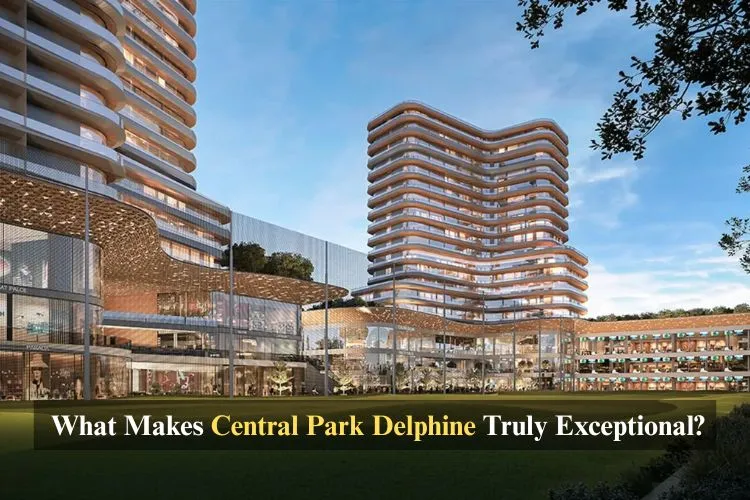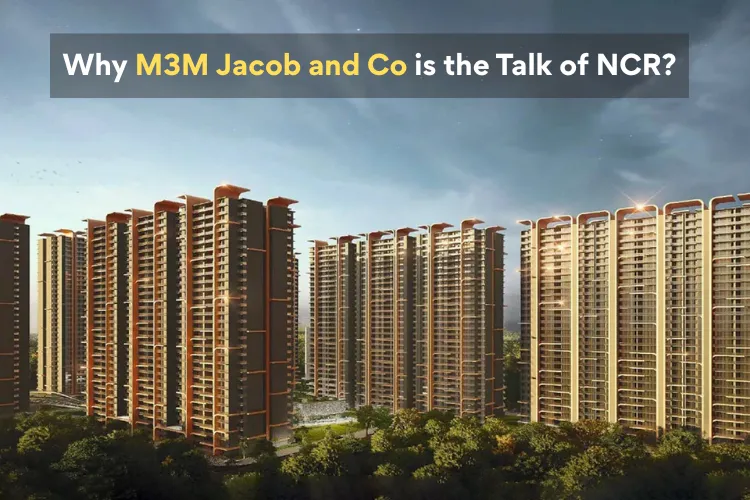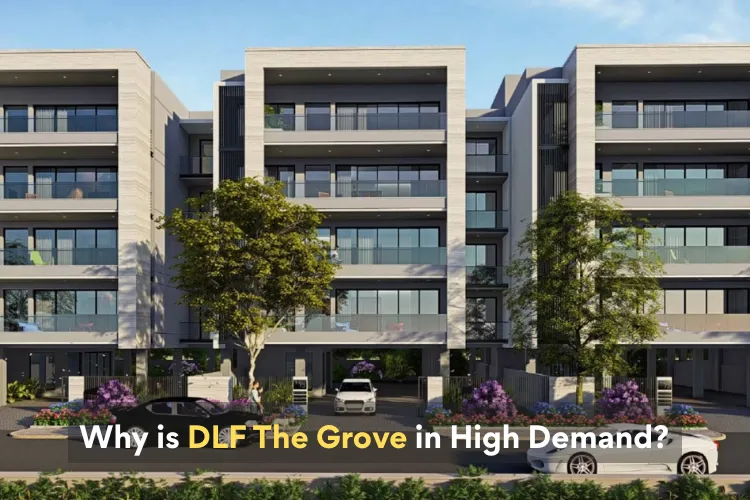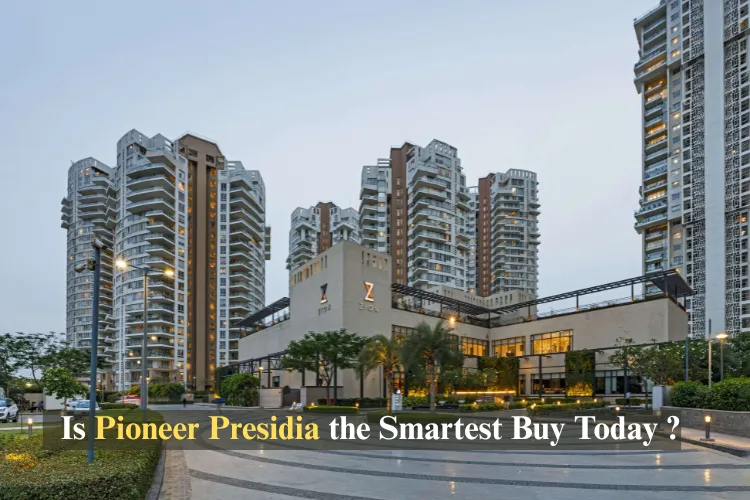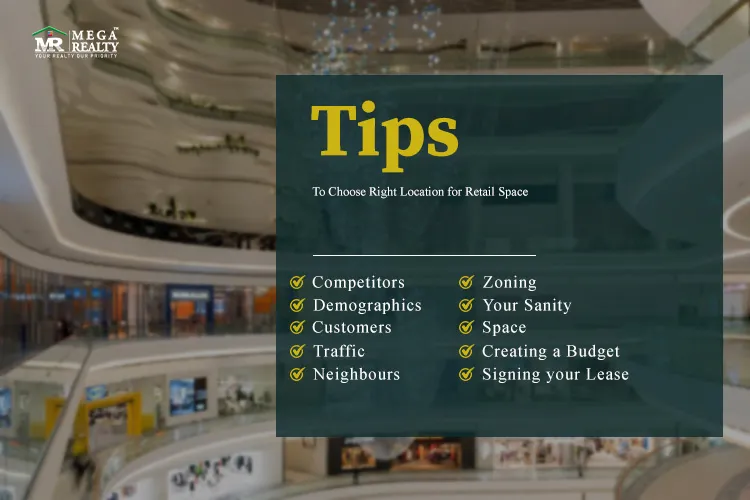
There has to be a very meaningful platform where the story of your brand meets real-life elements. That's exactly where choosing the right location for your retail spaces comes into play. Because it is not just about the transaction. It is about connecting with your audience. Hence, there has to be a very human touch to it. Every single footstep that stops to examine your brand, every glance through your catalogue, every sale begins with where your store lives.
In this blog, we have arrived at the top customer-centric tips and how to choose an appropriate location for your business. It has taken us countless nights of digging up data and a lot of brainstorming sessions to arrive at the same.
Table of Contents
- Steps to Choose the Right Location for Retail Spaces
- 1.1 Begin with a Clear Strategy & Business Vision
- 1.2 Create a Custom Retail Location Criteria
- 1.3 Map Your Trade Areas with Real Data
- 1.4 Pay Attention to Foot Traffic—Both the Quantity and the Quality
- 1.5 Make Accessibility, Visibility & Parking a Priority
- 1.6 Study the Types of Retail Location: Competitors & Co-Tenants
- 1.7 Make Sure Your Operations and Logistics Work Smoothly Together
- 1.8 Double-Check the Rules, the Basics, and any Sneaky Extra Cost
- 1.9 Use Technology to Validate Your Retail Site Selection Choices
- 1.10 Start with a solid budget, but leave room for your business to grow
- Bonus: Key Questions & Screening Steps to Your Retail Location Strategy
- Conclusion
Steps to Choose the Right Location for Retail Spaces
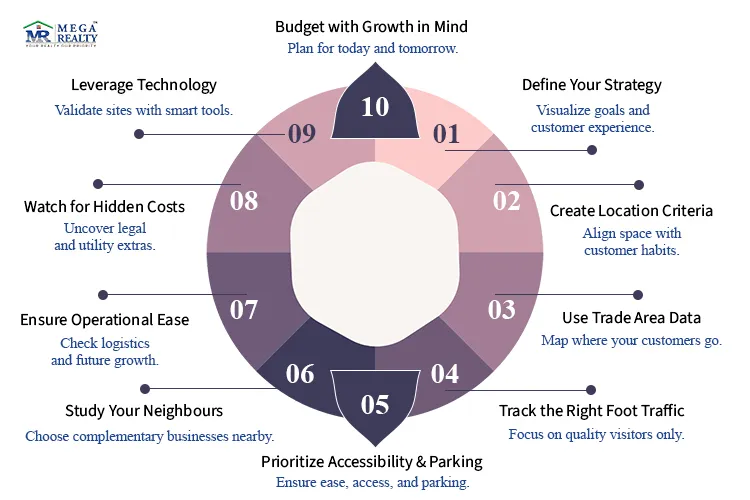
Let us now take a look at the top strategies you need to follow if you want to select the best location for your business.
Begin with a Clear Strategy & Business Vision
Before you even set out to choose the right location for your retail space, there are some things that you have to ask yourself. One important exercise is to mentally transport yourself to that place and visualize the entire experience. That’s the only way to truly understand and convey it.
Here are a few questions you can ask yourself-
- What kind of experience would I like to offer to my customers?
- Who would be my ideal customer, and what would be their age, lifestyle, and source of income?
- How much space in my retail location do I need to reserve for display, inventory, and backroom?
The first principle that you need to follow is that there will be no guesswork. You need to have a very good idea or a very clear picture of your strategy and your requirements. Then only you would be able to proceed.
Create a Custom Retail Location Criteria
Your brand is one of a kind. The route map to your location should also align with the same. Here are a few basic rules-
- You should make sure that your retail space is close to all the locations that your ideal customers visit, like parks, offices, etc.
- You have to make sure that during your peak hours, the traffic in the city is favourable for your customers.
- You need to pick layout traits that simplify the customer experience. These include walkability, the style of the storefront, and the ambience.
You see this little formula you’ve cooked up? It’s like your go-to guide for every property location you come across.
Map Your Trade Areas with Real Data
With the process of trade-area analysis, you can see where your people come from and where they go. You need to map everything, starting from where your best customers live, work, and spend time. After that, you should combine that with the census info, like age and income. Besides this, you can draw targeted rings around areas that matter most.
Getting in touch with a reputable real estate consulting company is a good step. Companies like Mega Realty Max focus on Gurgaon’s growing areas. Their team helps you match your customer profiles with the right hotspots. This makes it easier to map your ideal trade zones. Also, this erases the need for guesswork.
Pay Attention to Foot Traffic—Both the Quantity and the Quality
Counting the number of random people passing by your retail space location doesn't count. They have to be targeted customers who are visiting your location with the intent to buy or to engage with your services. This ensures amazing retail space management.
- You need to take a look at the peak times. These are lunchtimes, evenings, and weekends. These are the times when people are generally free. Do you think that customers would find it easy to visit your store during those peak hours?
- Ask yourself, what is the potential for conversion? Are these people who are passing by your potential customers?
- There is modern technology like mobile data, which will analyse the kind of people who are visiting your store. You should make proper use of that.
Even a small rise in foot traffic can boost sales in a big way. In 2024, retail space foot traffic went up by just 0.4%, but stores in top locations still saw noticeable jumps in revenue, proving that more visitors often mean more sales. Implementing these very basic points in your retail location strategy would help to convert the interest of your customers into actual intent.
Make Accessibility, Visibility & Parking a Priority
You need to communicate clearly to your customers what would be their points for convenience. If they visit your retail space, there has to be ample parking space, a good visibility and also, accessibility.
- Visibility: This one is important. Your retail store should be located in a prominent spot or defined in a way that people can't ignore it. Your retail location should be so compelling that people passing by your store aren’t able to ignore it.
- Accessibility: Your store should be near public transport. Also, there should be no qualms when people are trying to access your store location.
- Parking: There should be multiple spaces for parking per 1200 square feet. Let’s look at an example. Elan Empire in Gurgaon offers parking for over 1,200 cars across 4 acres. This ensures smooth access for both the shoppers and the tenants.
Study the Types of Retail Location: Competitors & Co-Tenants
You need to take a good look around yourself and see what other people in your vicinity are offering. It needn’t be a very competitive exercise. The purpose of it should be to analyse the chances of your retail store being a hit with your customers.
- For example, if there are two stores offering the same kind of product, people might notice you less. The chances of people choosing your store among others would be dicey as your retail location importance is reduced.
- If there are contrasting businesses, then there are chances of people visiting your store more. For example, think of a cafe that is located next to a bookstore. This is convenient as people can buy a book from the bookstore and then go to the cafe to spend some time there.
- Your neighbour should be complementing your business. They should not be eating away at it. You need to make sure that there are no problems in this aspect.
The key is to find solace in synergy and not to suffer in isolation.
Make Sure Your Operations and Logistics Work Smoothly Together
The key is not to offer a lot of glam just on the opening day. The point is to find a very sustainable and long-term solution to your retail store location. For this, again, there are some key factors to consider-
- Are your suppliers finding any difficulty in delivering the products to your retail location, or is it a seamless experience?
- Does the site have a loading bay, storage flow, and back-of-house space?
- If you decide to upscale your business 5 years down the line, would this retail location be a very good option?
Double-Check the Rules, the Basics, and any Sneaky Extra Cost
Take a good look behind the scenes before sealing the deal. In this aspect, too, there are some factors influencing the location of the store-
- See if local laws let you do business your way. One important thing is how long you can stay open or what kind of signs you can put up.
- You should make sure your retail location won’t leave you sweating, shivering, or without power. For instance, DLF Horizon Center in Gurgaon is designed with modern infrastructure. The systems ensure 24/7 power backup, central air conditioning, and energy-efficient systems.
- It’s not just rent. There are often add-ons like permits and insurance that could catch you off guard.
Ask the awkward questions today. This will save headaches tomorrow.
Use Technology to Validate Your Retail Site Selection Choices
Blend your intuition with solid facts for smarter and more informed decisions.
- Map out where your buyers are and check if the neighborhood fits the same profile.
- Look at actual foot traffic. Check the travel times to draw smarter boundaries in your retail space management.
- You could try to predict potential sales by measuring how attractive your retail space will be to customers nearby.
Start with a solid budget, but leave room for your business to grow
It’s not just about how much the retail space costs. You need to budget for everything from electricity to employees.
- If things go well, can you expand your retail location without starting from scratch? That matters.
- Dream big, but don’t bet it all. You need to make sure the numbers still work.
Bonus: Key Questions & Screening Steps to Your Retail Location Strategy
Before locking in a location for your retail space, you may run through these quick but crucial questions.
Self-Check Questions
- Does this place feel like you? And will your customers vibe with it too?
- Have you carefully assessed the different types of retail locations and then made your choice?
- Is there real data showing that the right kind of people pass through? Also, their expenditure?
- Can your team, supplies, and customers get in and out easily every day?
3-Phase Flow Process
Before anything else, figure out what “success” means for you.
Don’t settle for the first spot—compare, score, and see what checks the most boxes for your retail site selection.
Walk the space, read the fine print, and make sure everything adds up before you sign.
Following these steps makes the whole process feel way less chaotic. It helps to eliminate the noise.
Conclusion
Choosing the right location for your retail space isn’t just about logic—it’s also about feeling. When your brand vision clicks with what your customers want, what’s practical, and what’s possible for the future, a store becomes more than four walls.
It becomes part of someone’s everyday life. The right location does more than open a shop—it creates a connection. Here’s to making choices that feel right, grow with you, and turn your vision into a place that truly matters.
